Fall 2021: GLAS 120—Intro to Asian American Studies
Instructor: Karen Su
Final projects from two classes in the fall of 2021. Students either designed a lesson plan to support the Teaching of Equitable Asian American Community History (TEAACH) Act of Illinois or took an action to raise awareness of TEAACH or an aspect of Asian American Studies. Art projects are also physically on exhibit at the Asian American Resource and Cultural Center from May-Sept. 2022.
Michelle Dharma Heading link
Artist Statement: Depicted in this series of paintings are significant, yet untalked about, events of Asian American history. The hopes of this series is to timeline and articulate these key historical events while simultaneously creating awareness for the recently passed TEAACH Act in Illinois. Signed in April 2021, the TEAACH Act made history by making Illinois the first state to require Asian-American history be taught in public schools. This amendment in our education system will be required in the 2022-2023 school year, however many residents remain unaware about this fact. By creating awareness in Illinois and elsewhere, there’s hope to garner more recognition surrounding these unspoken, impactful events in Asian American history as well as the TEAACH Act.
[Three, hexagon-shaped canvases that are all 10 x 8.5 x 0.5 inches
Bio: Michelle Dharma is an Indonesian American student at the University of Illinois at Chicago, looking to graduate with a Biology major and Computer Science minor in 2024. Michelle holds a strong interest in Asian American culture and also enjoys painting in her freetime. In the future, Michelle hopes to continue to slowly add onto the series and timeline other lesser-known events that occured in Asian American history.
Michelle Dharma: Executive Order 9066 Heading link
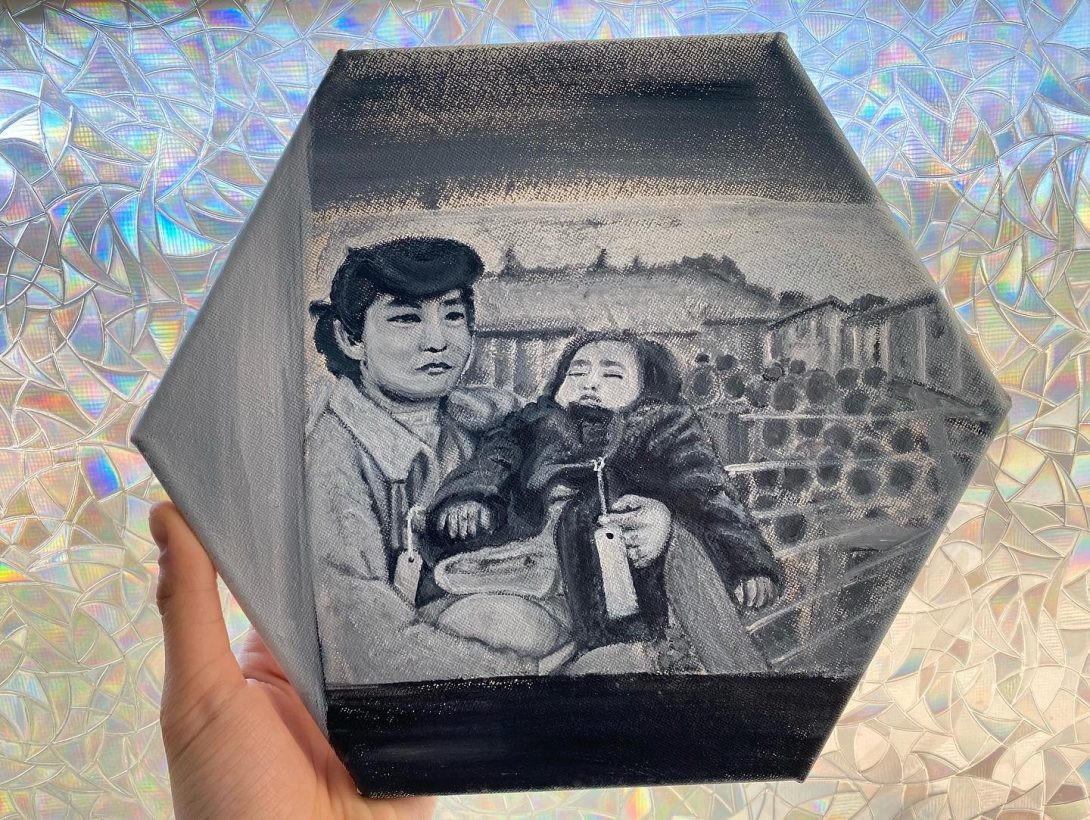
Executive Order 9066
(1942-1946) The forceful internment of 110,000 Japanese Americans after the attack on Pearl Harbor; these people spent up to 4 years in internment camps suffering harsh conditions and inadequate medical care; only after about 40 years of activism was an official apology and stipend sent out by the U.S. government for their wrongdoings.
Michelle Dharma: The Unjust Killing of Vincent Chin Heading link
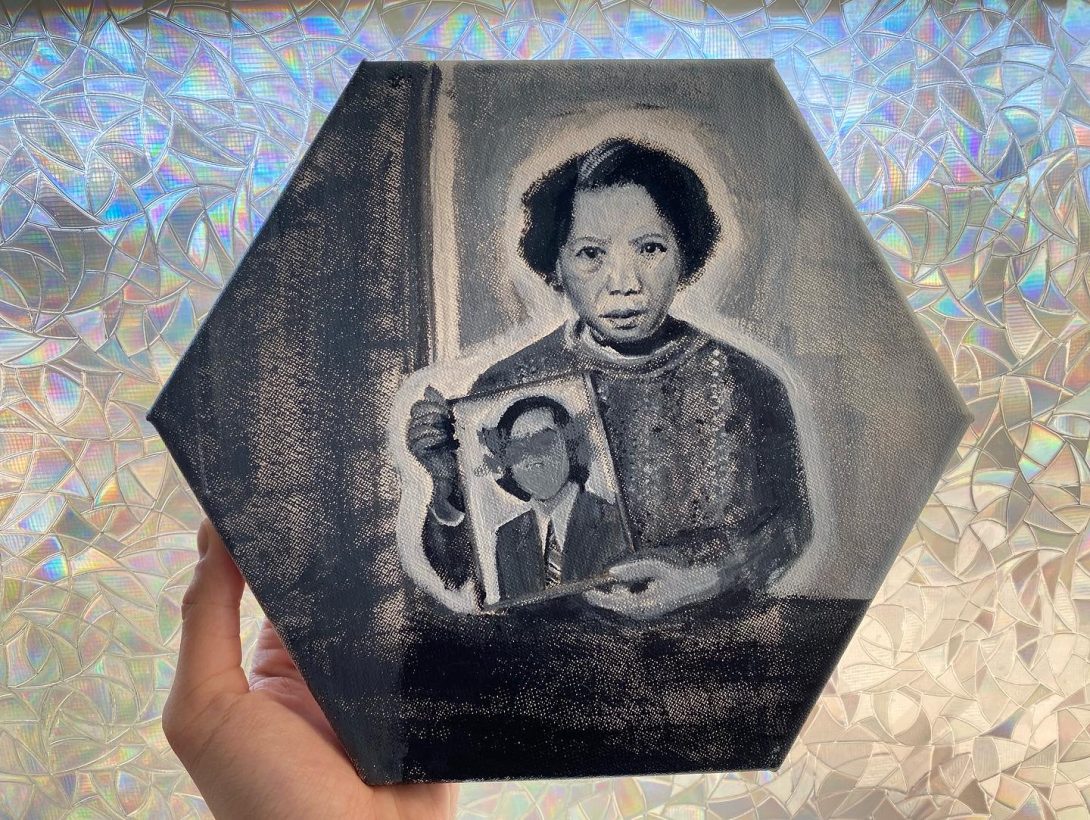
The Unjust Killing of Vincent Chin
(June 19, 1982) Despite being Chinese-American, Vincent Chin was beaten to death due to Ronald Ebens and Michael Nitz’s anger towards the Japanese auto industry; neither of the two men were imprisoned and were only given a 3 year probation sentence and a $3,000 fine, which to this day has not been paid.
Michelle Dharma: Post-9/11: Islamophobia Heading link
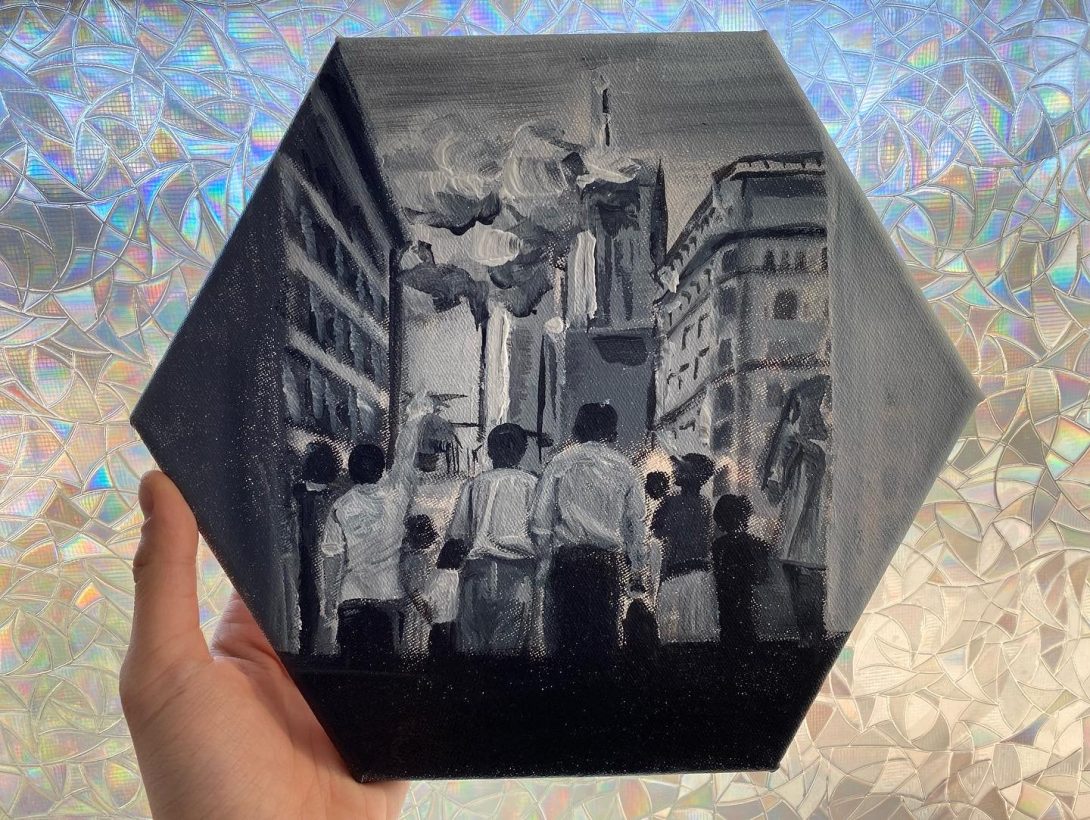
Post-9/11: Islamophobia
After the events of 9/11, Islamophobia ran rampant in the U.S., so much so that Muslims (and “Muslim-appearing” individuals) experienced various hate crimes; due to the fear of terrorist affiliations, the U.S. government mandated the registry of 83,000 men from Muslim-majority countries to register their name with the government; no terrorists were found, however, 14,000 of these men were still deported for various other reasons deemed by the government.
Tahira Syed Heading link
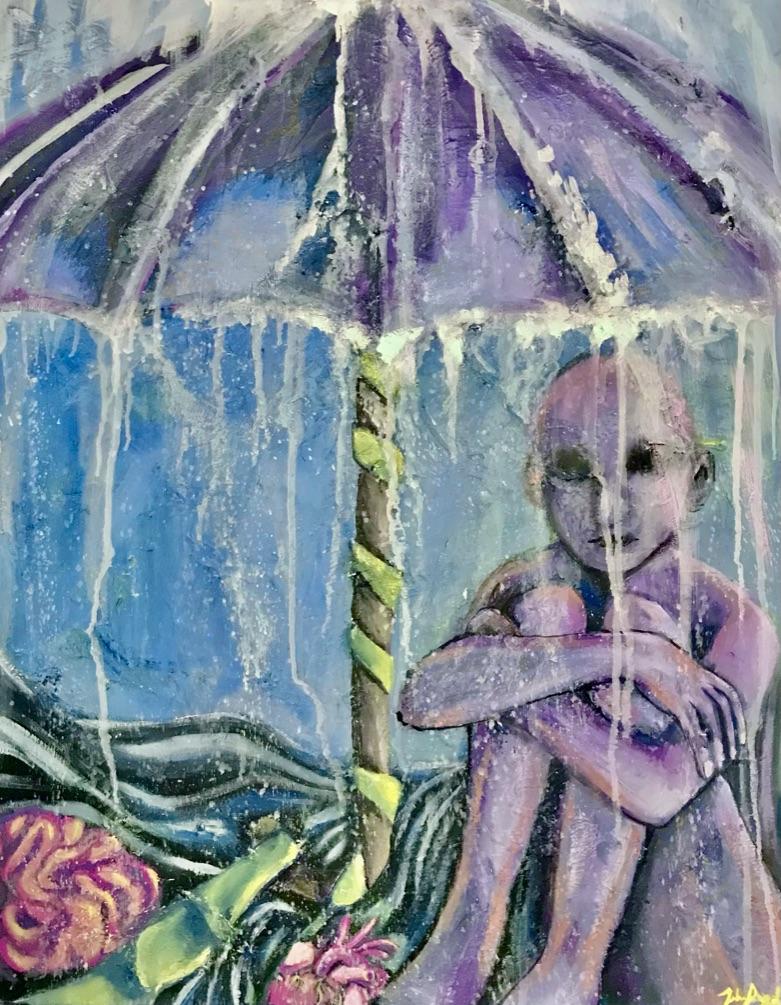
Art Title: ” Blue ”
Artist Statement: The stigma against mental illness is still at large today. While both Western and Eastern societies contribute to the stigma, I’ve noticed that most collectivist societies lack awareness in people’s mental health. Growing up in a South Asian household and community, there had been very little to acknowledge the well or unwell being of people. By creating this piece, I wanted to help raise awareness of mental health, specifically in Asian societies, by combining my passions in art and activism. In my piece, the texture of the canvas is bumpy caused by the layers of painted over tissue. This symbolizes the uneasiness in mental illness, and how it is difficult to overcome. All painted with watered down acrylic paints, “Blue” exhibits a lot more symbolism. The dimensions of my canvas are around 24 in x 30 in.
Tahira Syed: Blue Heading link

Bio
I am Pakistani American, and a second gen in my family. Since I grew up in a predominantly caucasian neighborhood, I was obviously different, leaving me and a few others to be a little “detached” from the rest. I was constantly thinking about what makes us so different and why there was a distaste towards poc. Because of our lack of knowledge, it’s harder to understand one another. That is why I think it is important to help teach people about different cultures and societies.
Rixzie Jimenez and Cassandra Rios Heading link
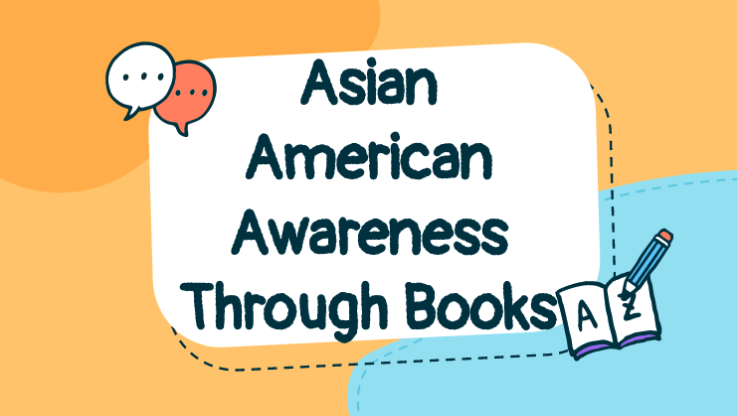
Asian American Awareness through Books
Rixzie Jimenez
Rixzie is a first generation college student at University of Illinois at Chicago. She is majoring in biomedical engineering. Rixzie was born in the Philippines and moved to the US at age 6.
Cassandra Rios
I’m a first-year student at UIC studying psychology. Iwas born in Chicago but later moved to the Northwest suburbs and experienced big differences in environments. Coming from a mixed family of Filipino and Puerto Rican descendants, I know how important culture can mean to many people. So when making this lesson plan I knew it would be great to try and get children to be proud of their culture as well.
View here:
Slide Show
Lesson Plan
Kara Fedrigon Heading link

TEAACH-ing Asian American History/Experiences
For my solutionary project, I decided to make a paper crane through the perspective of Asian American History. My content on TikTok (Karagamii) focuses mostly on crafts and origami. I thought that making a video that involves origami would be the best way to incorporate Asian American history. The easiest part of this project was filming myself making the crane. This took only 30 minutes and a few takes and afterwards I had to edit the video under3 minutes because that is the maximum length on TikTok.
The hardest part of this project was writing a script that was less than 3 minutes long. There was so much I wanted to say that would have made it too long. For example, I thought it was important to show the importance of the crane in Japan before navigating its history in America. However, I could have easily written a 3 minute presentation about the 12 year old girl, Sadako Sasaki, alone.
When I originally transitioned into talking about Japanese Incarceration, it felt too much like a history lesson. I remember that my audience was mostly children and wanted to find a way to engage them as an audience. I thought about our discussion in class about what we would bring if we were in that situation and decided to offer a hypothetical to the audience.“What if you imagined you were in that situation?” Then I began to talk about what Japanese Americans went through. Though I wasn’t able to provide the amount of detail or the level of context in the video I would have liked to, I think it created a much more digestible video for a young audience. I liked the idea of prompting the audience to think about the history whenever they folded a crane.
I had done some research on the camps and learned that people did fold cranes there to pass the time. There were also groups that folded cranes in support of Americans in those camps. Overall, I’m excited to be posting the video in May during API Heritage month.I do not usually post social content like this and generally stick to crafts and such, but I think the integration of origami into it will help bridge the gap. It will also be a very relevant hashtag, so hopefully TikTok will display the video on the Discover Page when featuring Asian creators for the month.
Bio: Kara is currently a sophomore studying Industrial Design at the UIC College of Architecture, Design, and the Arts. She has amassed 2.6 million followers on TikTok, and enjoys sharing the art of origami and paper crafting on the platform. She grew up in a mixed-race Chinese American household surrounded by art and design. Her mother, a first generation immigrant who also studied design at UIC, introduced her to origami at a very young age and also had a substantial collection of pop-up books for her to explore as a child. As such, Kara has always been fascinated with all kinds of paper art and continues to showcase Asian art forms like origami and other paper crafts as an Asian American creator on a predominantly Caucasian platform.
Brandon Ngo Heading link

Artist statement: I took an Asian American studies course in my senior year of high school which opened my eyes to all the things happening in my own community that I had no idea about. Taking GLAS 120 only opened them further. I had thought I already learned about everything in high school but now I realize that there are so many horrible things happening to Asian Americans everyday and have been happening for decades. How common it is only makes it worse because over time people become desensitized to it and the sheer number of incidents result in many of them being overlooked. I decided to draw the life of Vincent Chin in 3 pictures—two of them events leading up to his death, and the final being the result. Vincent Chin’s famous case only became well known because of his mother’s great efforts to make a change. More than anything it made me think about how many people that ended up like Vincent but never got the same coverage. I’m thinking about it as I write this: many, many Asian Americans may have been brutally killed without even ever having their names in the morning paper.
Bio: English Creative Writing Major and Art Minor. Aspiring Graphic Novelist.Artist tag: veuilo_
Short Comic for Vincent Chin
For my final project, I decided to draw a short comic for Vincent Chin because the documentary inspired me so much. I took an Asian American Studies class in high school and learned a lot about Chinese Americans working on the transcontinental railroad, Japanese internment camps, and the Vietnam War. I was surprised to find out about Vincent Chin and how big of a movement it was. It made me realize that I still have a lot left to learn about Asian American history, but more importantly, I realized that so much of what happens to Asian Americans goes unnoticed.
I wondered how many people had similar experiences to Vincent Chin and about how I’ll never know about the hundreds, maybe thousands of people like him because they are forgotten. That’s why I wanted to make something to post to help people remember Vincent Chin. It was difficult because I assumed that I could do it quickly, but it turns out drawing and coloring out 3 panels and adding text, along with finding fonts and good colors, would take up more than a day to finish. I don’t consider myself a good artist so it took me a long time for each part of the process. I had to also find references. Because of time constraints and poor planning, I was unable to color the second panel, so I left it in greyscale.
In hindsight, the black and white tones add to the dark tone for the scene. Nonetheless, the next time I decide to do a project like this I should plan ahead so I could submit the best work that I can do. In the end, it wasworth it though because I posted it on instagram and received good feedback from friends who wondered what the project was about. Because of that, I was able to share with them what I learned from the class and keep a conversation going about Asian American studies.
I think overall that my project was a success then because Vincent Chin’s memory and legacy will continue to live on in people’s mind and in their heart.
Seiya Abe-Bell Heading link
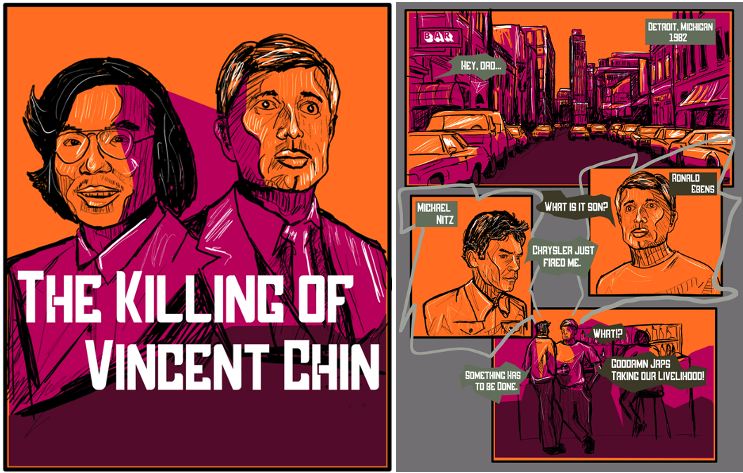
Artist Statement: I am a studio artist. In my practice, I work with a wide array of visual mediums using drawing, acrylic painting, photography, and digital illustration. While not as prevalent in my practice I also work in sculpture, oil painting, collage, and mixed media. Throughout my work, I incorporate the use of recycled materials found on the street or generated by myself such as plastic and glass bottles, cardboard boxes, car parts, and discarded furniture. My sculptures, comprised of recyclables and acrylic paints are mainly created using these materials. Through my art, I hope to exhibit the fundamental issues we all face in this internet age, in an emotional visceral way. Not only this but I hope to inspire others to create and pursue change. As I grow older I’m starting to notice a tendency for those in my generation (including me) to idle when there are things to be done. Being a part of this young culture, I am able to capture my generation’s thoughts and feelings into a record of the present. Currently, I am working on my own lackadaisical nature and will create work to inspire others to do thesame. All the while showcasing the issues I believe need to be addressed: The current condition of our environment, the mindset of our youth, mental health, and equality.
Bio: Seiya Abe-Bell is an Asian American artist who is half Japanese and half African American. Seeing the events of the Black Lives Matter and the Stop AAPI Hate movements unfold in the past years has made a drastic impact on his life. By taking part in this showcase he hopes to generate more awareness by using his art. Not only this but he sees this as a milestone in understanding his own Cultural background.